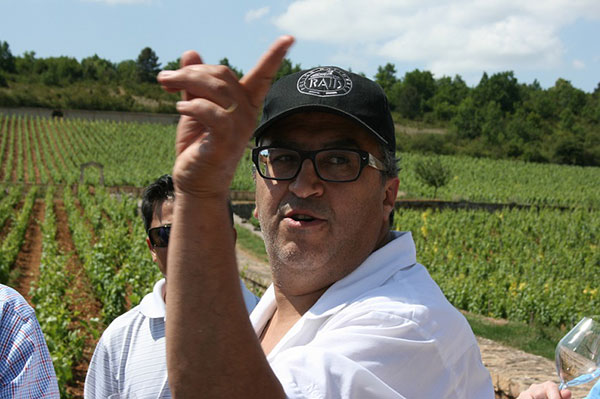By Andrew Jefford
Few regions have had worse luck with the weather over the past four vintages than Burgundy: a 30% shortfall in 2010; 25% down in 2011; only half a crop in 2012 and 2013. That makes one-and-a-half missing harvests in four years. Or, if you prefer, about 1.5bn potential euros swirling off down storm drains, or quietly collapsing in a fluff of mould.

Mounir Sawma, who runs the micro-négociant and wine finisher Lucien Le Moine with his wife.
Which was why, the week before last, as hail flayed unlucky Cognac and the Northern Medoc, it was encouraging to see so many Burgundian smiles. ‘It was all over in four to five days,’ said Bernard Hervet of Faiveley. ‘It was the best flowering I have ever seen.’
I know of no one in Burgundy who speaks with more passion, articulacy, exuberance, irreverence and sometimes wild poetry about different vineyard sites than Mounir Sawma. Mounir runs the micro-négociant and wine finisher Lucien Le Moine with his wife Rotem Brakin. When it was time to organise a vineyard walk from Puligny up to Montrachet itself with a group of visiting American wine students, I figured Mounir would provide insights which no one else could.
After memorably psycho-analysing this gently sloping walled vineyard and its family, shared between Puligny and Chassagne, he began pouring wine from six half-bottles of as-yet-unfinished 2012 Lucien Le Moine whites. The first wine we tried was a mystery bottle (quince and pear scents; vivid, sappy flavours).
Then came samples of Bienvenues-Bâtard-Montrachet (iodine and cream), Criots-Bâtard-Montrachet (pungent, stony – and peaty, according to Mounir), Bâtard-Montrachet itself (lush yet sinewy, “a red wine with a white flavour”) … and, amazingly, two samples of Montrachet from each side of the village divide. One was festive: deep, enchanting, nourishing and peacock-like. The other was much stonier, more attacking: a searchlight, scouring the night hillside – and it had some of those faint pear and quince fruits. Which was which?
Most of us felt (by reputation rather than experience, alas) that the peacock must be Puligny and the searchlight Chassagne. So it proved; but what, then, was the mystery sample? Mounir’s trump card: a Murgers des Dents de Chien, St Aubin Premier Cru – grown on the fingers of the hill, as it happens, which reach down and very nearly caress Montrachet itself on the Chassagne side.
Point made: we could smell the kinship, and we eagerly hunted down this affordable PC on the wine list of that evening’s restaurant. It’s not Montrachet, of course, but what the wine custodian in baseball cap and Hard Rock Café sweatshirt had shown us was Burgundy’s most inspiring and enduring lesson: that even the tiniest nuances of site can find, in wine, a sensual being.
